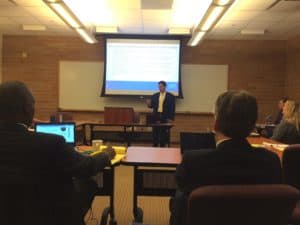
Herman Aguinis
Star performers represent a slim minority in most fields, and the ongoing challenge for management is to better understand how to find, cultivate and retain them, says Herman Aguinis, PhD, Avram Tucker Distinguished Scholar and professor of management at The George Washington University School of Business.
“The stars get many more perks than anybody else—they clearly get a bigger slice of the pie,” Aguinis says. “But they create a larger pie and more value for the collective if you manage them correctly.”
Aguinis spoke to Daniels College of Business Executive PhD students on Jan. 25. Widely regarded as a leading authority in the management field, he is vice president of the Academy of Management and will become its president in two years. An expert in organizational behavior, research methods, psychology and human resources management, Aguinis has written nearly 200 journal articles, edited major journals and authored several books, including the upcoming “Performance Management for Dummies.”
“I’ve known Herman for the past 20 years, and he’s someone I really look up to in the field,” says Daniels Louis D. Beaumont chair of business administration and professor of management Donald Bergh, PhD, who introduced the lecture. “He develops great theory and methods, and is an educator for all of us.”
Aguinis told the group that his research focuses on two main areas—talent management (including leadership and people analytics) and improvement of measurement methods that will enable data to drive better decisions. In those realms, his ultimate goal is to foster organizational, individual and societal improvement.

Aguinis speaking to Daniels Executive PhD students
“I offer solutions—not just to improve the financials of organizations but also to improve the well-being of people who work for those organizations,” he says.
His research into star performers, for example, generated some intriguing findings that have prompted many follow-up studies. For their initial study, published in The Journal of Personnel Psychology, Aguinis and colleagues assessed 510,000 people in 120 different occupations and found “stars” in 91 percent of occupations. The result, he says, is that rather than their findings generating a typical bell-shaped curve where the majority of employees are “average,” the data showed that most workers are below average, while a small number are high, or star, performers. Here are a few examples:
- About 65.8 percent of academic researchers fall below the mean number of top-tier journal articles published.
- 3 percent of Emmy-nominated performers fall below the mean in terms of number of nominations.
- 9 percent of elected members in the U.S. House of Representatives fall below the mean in terms of number of times elected.
- 1 percent of NBA players are below the mean in terms of points scored.
The remaining 9 percent of occupations, he notes, tend to be assembly-line jobs in which employees can only move as fast as the line and therefore cannot perform better than anyone else to become a star.
“Today, most of us are not working in these assembly-line professions,” Aguinis says, noting there is no limit to the number of papers an academic can write or the number of Nobel Prizes a scientist can win. “The more autonomy, the more pay for performance, the more job complexity and skills needed, the more you can have a large number of stars.”
The challenge for many companies is to improve their methods for measuring performance, he says, pointing to Google and Capital One as examples of two companies that are taking talent management very seriously.
“Companies need PhDs to interpret research that provides solutions to some of these challenges,” he says.
Next steps for his future research include developing longitudinal data in following star performers over time as well as a study assessing why so few female versus male stars exist in STEM fields, despite significant amounts of money and resources dedicated to encouraging girls in these fields.
Executive PhD students, James Corbett and Dawn Reed, found the lecture both stimulating and filled with important insights.
“What stood out for me was to make sure we’re measuring what we’re intending to measure,” Reed says, adding, “We must read at least 10 articles a week in this program, and to be able to put a practical spin on things is really refreshing.”
“Today was the most pivotal moment of the course—having access to him,” adds Corbett. “My brain is firing on so many different levels.”
For more information on Daniels’ Executive Phd program, visit daniels.du.edu/executive-phd/.
